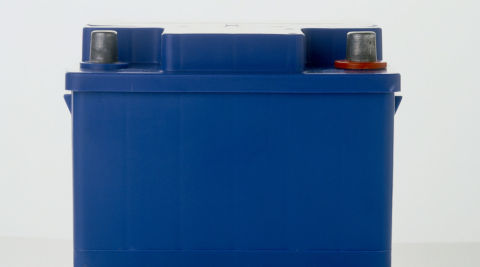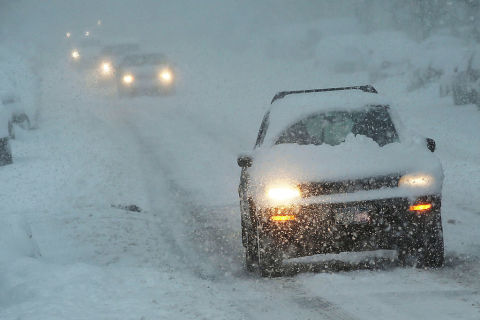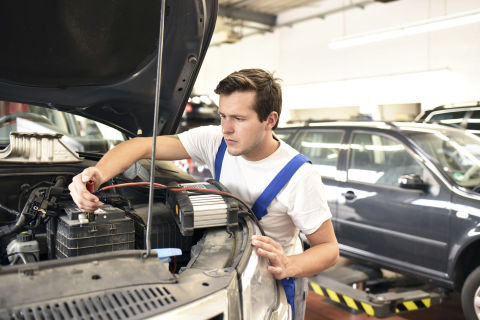We debunk some myths and add tips to taking car of this hugely important part in your car.
f you're driving a gas guzzling SUV, electricity remains crucial to
driving a car. Thanks to modern-day electric batteries, drivers no
longer have to turn an engine over by hand. It now all happens with the turn of a key or a press of a button.
But
beyond that initial ignition, the battery continues playing a vital
role in all of your vehicle's electric systems, but some myths have
circulated about this electric heart pulsating in all our autos. Here's a
thorough examination of those myths and some some cold, hard facts to
replace them.
Battery Life (and Death)
A car battery should last about six years,
but like most car parts, that all depends on how you treat it. Multiple
discharge/recharge cycles shorten any battery's life and using
electronics in the car while the engine is the quickest route to a dead
battery. Of course, a battery can maintain a charge while the engine is
on, but once it's off electronics draw directly from the battery.
To
avoid this recurring auto nightmare, always turn the headlights and
interior lights off when you're done driving. Remember that leaving
electronics like GPS or cell phones plugged into a car charger can drain
the battery, too.
No
matter how well you take care of it, eventually your battery will die
and you'll need a replacement. Failing batteries usually display obvious symptoms
that let you know it's on its way out. Slow cranking on startup
indicates that the battery may not be able to provide enough power to
fire up the engine, and an illuminated Battery Warning Light
on the dashboard is clear indicator it needs attention. If vehicle
electronics like remote locks or interior lights randomly stop working, a
dying or dead battery could be why.
Also, batteries—alive or dead—are full of chemicals, so do nature a favor and dispose of dead ones properly. Don't just toss it in the trash because chances are your local mobile mechanic or auto supply store can recycle it for you.
Weather Matters
Ambient
temperature has a significant impact on battery life and performance.
Most car batteries use a liquid electrolyte solution to hold a charge,
which is affected by hot or cold weather. While it takes extremely low
temperatures to freeze a battery, cold reduces the solution's ability to transfer full power (which is why it can be hard to start a car in winter).
There's a misconception that buying a battery with a higher CCA (cold
cranking amp) rating will remedy this, but since vehicle computers
regulate the amperage required for startup, it actually won't make any
difference. Use a battery heater instead – it's like a toasty jacket
that will keep your battery warm and reliable all winter.
On the flip side, hot weather can cause the battery solution to evaporate,
limiting its ability to hold a charge. You may notice a rotten egg
smell from the sulfur in the solution if this happens. A common myth is
that you can simply refill it with tap water to make up for evaporation,
but tap water contains minerals and impurities that can damage battery
cells. Use deionized or demineralized water instead, but if you have to
do this it's probably a sign that you need a replacement soon. Keeping your car garaged helps the battery cope with temperature extremes so it lasts longer and works more reliably.
Jumpstarting Made Easy
Advertisement - Continue Reading Below
Almost every driver has to deal with a dead battery, and jumpstarting
is usually the easiest way to get it recharged. It's a relatively
straightforward process, but it's still important to follow these steps
exactly.
Here's how it works. First, to jumpstart a car, you will need:
- A set of jumper cables
- Another vehicle with a fully charged battery of the same voltage of the car being jumped
- Rubber work gloves
- Safety goggles
Before
jumpstarting your car, read the owner's manual. The process is similar
for most cars, but there may be special considerations for your specific
vehicle.
- Park the vehicles close enough that the jumper cables reach each battery.
- Make sure each vehicle is in Park or Neutral.
- Turn off the vehicle with the good battery.
- Turn off or unplug any electronics, including headlights, hazard lights, radios, or cell phone chargers in each vehicle.
- Open the hood of each vehicle and put on the work gloves and safety goggles.
- Connect one end of the red (positive) jumper cable to the red positive (+) post of the dead battery.
- Connect the other end of the red (positive) jumper cable to the red positive (+) post of the charged battery.
- Connect one end of the black (negative) jumper cable to the black negative (-) post of the charged battery.
- Connect the other end of the black (negative) jumper cable to an unpainted metal part in the dead car, as far from the battery as the cable will reach. This grounds the circuit and helps prevent sparking.
- Now you're ready to actually jumpstart the car. Turn on the car with the fully charged battery and let it idle for roughly five to 10 minutes. Revving the engine won't help: jumpstarting draws amps from the good battery, which is unaffected by engine power.
- Turn off the engine and remove the cables in reverse order, being careful to not let the clamps touch any metal surface.
- Start the car with the dead battery. If it starts, let it idle for at least 20 minutes, or go on a five-mile drive so the battery can recharge. If it still won't start, repeat the process.
Jumpstarting
is one way to get your car started again, but remember that every time a
battery is fully discharged its life becomes shorter. If nothing else,
the alternator will have to work harder to recharge that drained
battery, which reduces fuel economy.
It's Not Always the Battery
If your car won't start, a dead battery is the likely culprit. However, there are numerous components that can cause similar symptoms. A faulty starter motor will make a click when you turn the key that sounds similar to a dead battery. If the alternator fails, the battery won't recharge when the engine is on, leading to a no-start condition. Clogged fuel injectors or worn-out spark plugs
can be a problem, and corrosion on the battery terminals, which
prevents the flow of electricity, is common too. Fortunately, it's easy to clean with a wire brush or steel wool.
With
the popularity of all-electric vehicles soaring, there's a good chance
your next car will be powered entirely by batteries. But until then,
follow these steps to keep your current gas guzzler in shape so that you
never have to break out the jumper cables.





0 comments:
POST A COMMENT